Burn Pits – The Agent Orange of the Iraqi War
- News & Events
- News
- Burn Pits – The Agent Orange of the Iraqi War
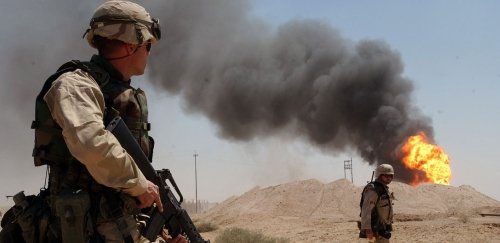
Service members are returning from Iraq and Afghanistan with chronic – even deadly – illnesses
The same deadly chemicals found in the herbicide Agent Orange that was sprayed on the jungles of Vietnam during the Vietnam War are being released in burn pits on U.S. military bases across Iraq and Afghanistan.
“Otherwise healthy U.S. service members are returning from deployment with cancer, leukemia, respiratory illnesses and other chronic conditions,” said Chelsey Poisson, a RIC nursing student with prior military service in the R.I. Army National Guard. Poisson has made it her mission to advocate for service members who have been exposed to burn pits and to push for legislation to change military policies.
Burn pits are massive holes backhoed in the ground to dispose of waste/garbage on U.S. military bases. One of the largest burn pits – at Joint-Base Balad in Iraq – spanned 10 acres. Smaller metal barrels are used at smaller platoons. The danger, Poisson said, is what is being burnt in them.
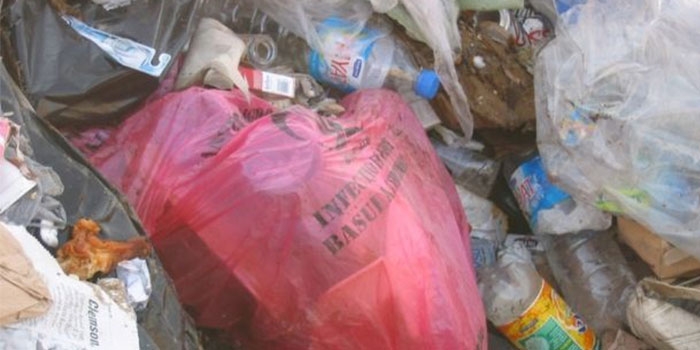
“Everything is burned,” she said. “Because you’re in a war zone, you can’t call up the local waste management or recycling company to come by and pick up your trash. So the military thought the best way to get rid of their waste is to dig a large hole, pour in diesel fuel and set the trash on fire.”
“Burn pits smolder for weeks or months at a time, often around the clock,” she said. “When diesel fuel burns it releases benzene, a known carcinogen.” Benzene, she added, is also contained in many of the items being burned – paints, solvents, paint thinners, rubber, pesticides, chemically-treated uniforms, Styrofoam and plastics.
And plastics proliferate on base, she said. Plastic water bottles have replaced canteens, and plastic utensils have replaced their metal counterparts. When plastic burns it releases the same dioxins found in Agent Orange, another known carcinogen.
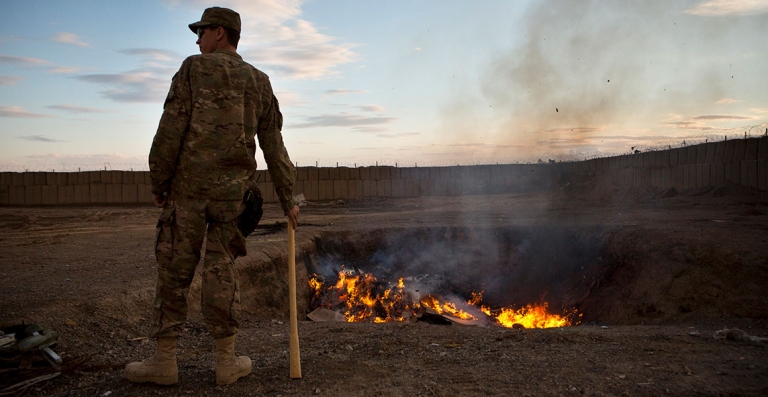
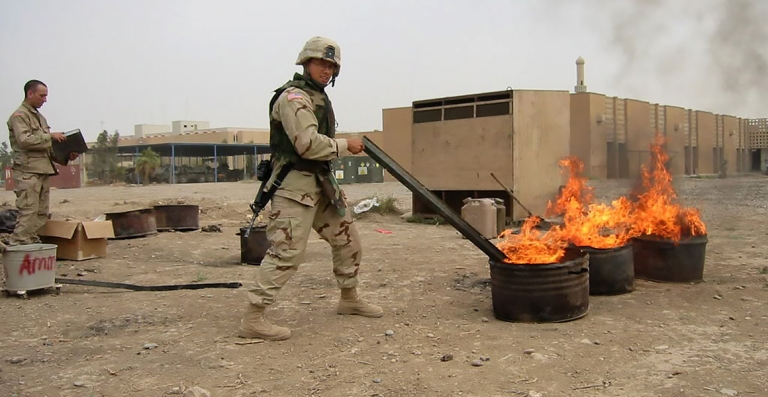
Exposure to benzene, dioxins and other toxic chemicals occurs through inhaling or passively ingesting the fumes, gases or ashes. If toxic ash settles in water bottles, eating utensils or on cigarettes, it can be passively ingested orally, while airborne ash that settles on the very fine Iraqi sand can enter the lungs during strenous work or outdoor exercises.
Joint-Base Balad, an air base, had one of the largest burn pits in Iraq, said Poisson. “On average, 147 tons of garbage were burned per day,” she said. “Burning operations ran 24 hours a day, seven days a week, to keep up with the trash accumulating on the base.”
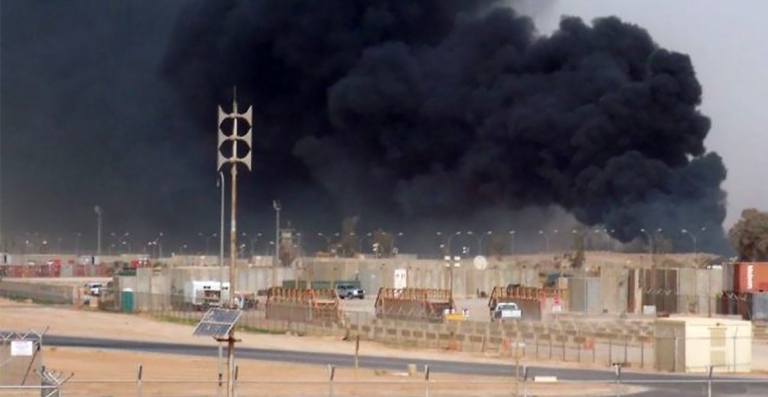
Poisson quoted bioenvironmental engineer U.S. Air Force Lt. Col. Darrin Curtis, who stated in a 2006 memorandum,Balad’s burn pit is “the worst environmental site I have personally visited…I’ve witnessed burning plastics, Styrofoam, medical and non-medical wastes while using jet-propellant fuel as an accelerant…It is my professional opinion...that there is an acute health hazard for individuals.”
Poisson also quoted former U.S. Air Force Technical Sgt. Amie Muller, who had been based at Balad. Muller stated, “I inhaled that stuff all day, all night. Everything that they burned there is illegal to burn in America…it always felt like no matter what shift you worked, the wind always switched and followed you, so it was there when you were at work, it was there in your tents. There was no escaping it.” Following Muller’s return from deployment in 2007, she was diagnosed with pancreatic cancer and died in 2017.
As part of her nursing honors project, Poisson began an in-depth, evidence-based literature review in 2017 on the health effects of burn pits in Iraq. In 2018 she put together a burn pit survey for Iraq War Veterans.
Poisson noted that although the U.S. Department of Veterans Affairs has a Burn Pit Registry – a questionnaire for Veterans and service members to fill out to support their claim that they came into contact with certain environmental hazards – “the registry is hard to log on to, the site frequently crashes” and “I believe they are asking the wrong questions,” she said.
Poisson developed her survey with the assistance of her academic and honors project advisor RIC Assistant Professor of Nursing Sylvia Ross as well as RIC Assistant Professor of Nursing/Lt. Col. Sheri Boucher, a former U.S. Air Force flight nurse who had been based in Afghanistan. The survey was approved by the college’s Institutional Review Board and released to the public in July 2018. Within two weeks, 100 veterans had responded.
“Our hypothesis was confirmed,” Poisson said. “Iraq War Veterans exhibited a decrease in overall physical fitness test scores and a significant increase in medical symptoms post-deployment.”
Poisson pushed further, creating a website called Hunter Seven (www.hunterseven.org) designed to provide Vets with information on military-specific exposures. Among the resources this site offers are a list of toxic chemicals, in what items they are found, and their physiological effects.
She also established the Hunter Seven research team, made up of Ross, Boucher and Master Sgt. Paul Santilli, who is a RIC M.S.W. student, a VA social worker, a member of the R.I. Army National Guard and a four-time Iraq War Veteran with medical issues related to burn pit exposures.
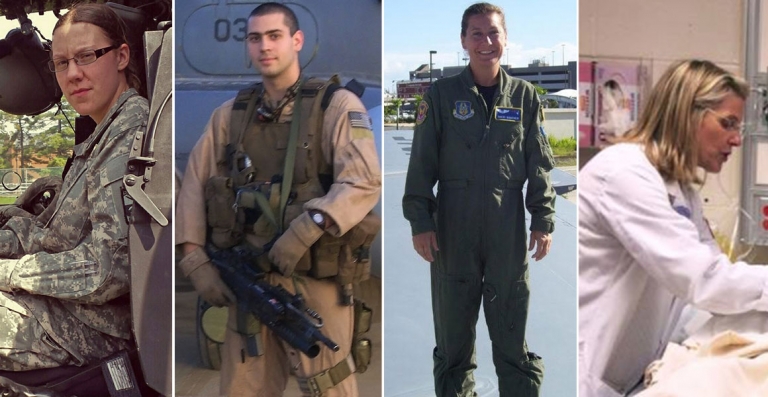
“We’re a dynamic inter-professional team,” said Poisson. “Dr. Ross is an amazing writer and researcher. Lt. Col. Boucher is the subject expert, my go-to with questions. And Master Sgt. Santilli helped me bridge the gap between research and policy change. His experience and passion is much like my own.”
The Hunter Seven team is now pushing for legislation. In 2018 Poisson met with U.S. Rep. David Cicilline to share her research findings and to solicit his support in co-sponsoring two bills on burn pit accountability and protection for Vets (H.R. 5671 and H.R. 6582). Cicilline whole-heartedly agreed. Later, Poisson and Santilli met with the Veteran Affairs representative for U.S. Sen. Sheldon Whitehouse, requesting that Whitehouse form a companionship bill, which Whitehouse has also agreed to.
Legislation would ensure that service members are informed of possible long-term health risks related to burn pit exposure. It would ensure that documentation of exposure becomes a permanent part of every service member’s medical record. It would also help codify the VA’s response to veterans returning with conditions linked to exposure. Most importantly, legislation would arrest future exposure by requiring safer methods of incineration.
For her service to the nursing and military community, Poisson, a native of Massachusetts, received a citation from Mass. Gov. Charlie Baker and Lt. Gov. Karyn Polito. She was recognized by Mass. Sen. Richard Ross and U.S. Mass. Sen. Elizabeth Warren as well as R.I. Gov. Gina Raimondo’s Office of Veterans Affairs, which have pledged their full support.
“I’m not doing this to win honors,” Poisson stated. “I come from a military family. My fiancé Kyle Simoni served in Iraq as well as his brother. Kyle is now battling symptoms related to burn pit exposure and three of his closest friends who served with him have died of cancer, leukemia and respiratory failure.”
“I do this work because the lives of the people that I love and care about are at risk,” she said.
Poisson graduates from RIC’s B.S.N. program in December 2018. Her intention is to continue her research and to work at a VA medical center, specializing in mental health and public health. As of the writing of this article, burn pits remain active in Iraq and Afghanistan.
